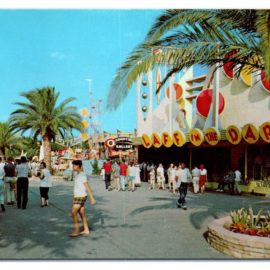
Not what it looks like today and, personally, I would prefer it stay a beach not a carnival.
The Pontchartrain Beach property, a mile-long sand beach near the Seabrook Bridge that has been closed for decades but remains popular with some New Orleans residents, could officially reopen under a new manager. The Lakefront Management Authority, which currently controls the property, agreed in March to request bids from organizations that could make the beach safer for swimmers, anglers, and other outdoors enthusiasts. The authority will release its request for proposals sometime this week . “What we’re doing now is testing the waters to see what proposals will come in, and what ideas are out there to develop this old beach site,” authority Executive Director Louis Capo said.
nola.com
This is the second beach to come under “should we bring it back” as Lincoln Beach has also been thought of.
It’s the second Lake Pontchartrain beach revamp local officials have pondered in recent months. Mayor LaToya Cantrell’s administration announced plans last year to revive Lincoln Beach along Hayne Boulevard in New Orleans East, a waterfront aimed at Black residents during segregation that has been closed for more than 50 years. Established by the Batt family in 1928 on the present-day site of the Lake Terrace subdivision, Pontchartrain Beach was an amusement park that was for White residents only until the Civil Rights Act passed in 1964. In the early 1930s, the park moved to the foot of Elysian Fields Avenue in Gentilly, where it remained until its closing in 1983. Rides were sold off or donated, and much of the land is now used by the University of New Orleans, which opened a research park there. The main sliver still standing is the mile-long stretch of sand near the Gentilly bridge, located behind Lakeshore Drive where Elysian Fields ends in a roundabout near the lake’s shore. Though the area is officially closed due to underwater hazards that make swimming perilous, it has still been used by swimmers over the years.

https://en.wikipedia.org/wiki/Lincoln_Beach_amusement_park
There was a change in the lease years ago and now the beach belonged to the Levee District but then to the Pontchartrain Conservancy.
This would not be the first time an organization has leased Pontchartrain Beach. As a property owned by the Orleans Levee District, it’s been leased to UNO, which brushes up against the beach’s shore, and the Pontchartrain Conservancy, a nonprofit focused on environmental sustainability. When the conservancy, then dubbed the Pontchartrain Basin Foundation, took on the lease, it had aspirations to reopen the beach and to clean up the entirety of Lake Pontchartrain. But the nonprofit didn’t realize that reopening before its lease expired in 2018. The beach then fell under the purview of the management authority. “Now, it’s not under lease anywhere. But state law requires it can only be used for a beach. You couldn’t put a business there,” LMA board member Wilma Heaton said.
The Pontchartrain Beach Foundation has been formed and desires the lease.
At least one group hopes to be selected to revive the property. The Pontchartrain Beach Foundation, founded by Guy Williams, the CEO of Gulf Coast Bank & Trust, asked the authority’s board for permission to lease the beach in December. Williams said his group wants to clean up and reopen the beach for swimming, kayaking and other outdoor activities. “There just aren’t many options in our area to get out on the water for free,” Williams said. Williams’ group has worked independently to help restore the beach by putting fracking sand at the site, he said. Though his presentation was not a formal proposal, it inspired the authority to consider leasing the beach to a manager. “Our focus would be on step one, which is actually getting funding and the renovation that’s needed so that the beach can be reopened,” Williams said. “If we don’t do step one, there will never be a step two.”
There are still remnants of the amusement park that will have to be removed.
Any renovation to make the area safe for the public would require removing some of the remnants of the beach’s earlier glory. Old amusement park structures are buried in the beach’s sand, and can cut people who don’t see it. There’s also a steep drop-off and riprap, a rock material used for shorelines, under the water that’s unsafe for swimmers. The authority plans to weigh all proposals it receives, said Anthony Richard, its chairman. “We have one responsibility of overseeing the properties within our realms on behalf of the public,” he said. “We’re trying to get an appreciation on what would be the best use for that particular space that’s available that ties into our mission.”
A free beach for all to swim, fish and boat. What is not to like?



